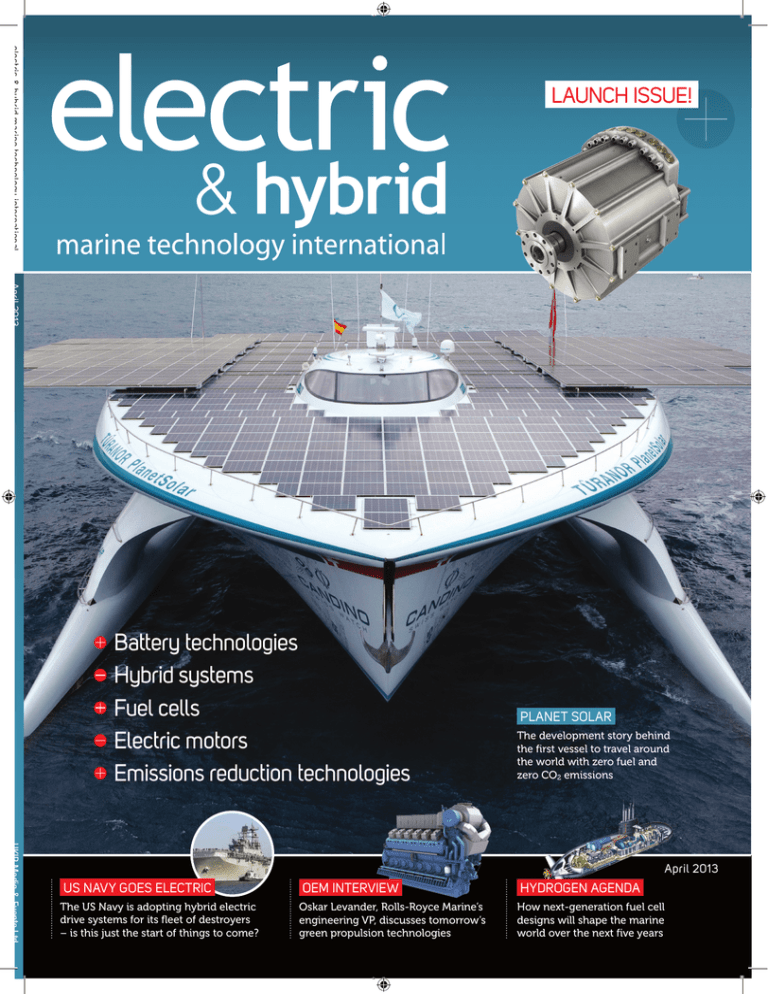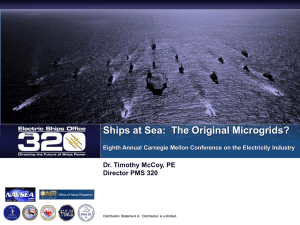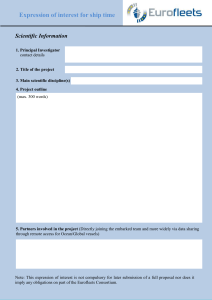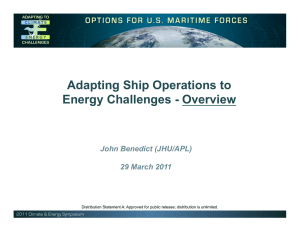Battery technologies Hybrid systems Fuel cells Electric motors
advertisement

electric & hybrid marine technology international LAUNCH ISSUE! April 2013 Battery technologies Hybrid systems Fuel cells Electric motors Emissions reduction technologies PLANET SOLAR The development story behind the first vessel to travel around the world with zero fuel and zero CO2 emissions UKIP Media & Events Ltd April 2013 US NAVY GOES ELECTRIC The US Navy is adopting hybrid electric drive systems for its fleet of destroyers – is this just the start of things to come? OEM INTERVIEW Oskar Levander, Rolls-Royce Marine’s engineering VP, discusses tomorrow’s green propulsion technologies HYDROGEN AGENDA How next-generation fuel cell designs will shape the marine world over the next five years US NAVY GOES ELECTRIC US NAVY GOES ELECTRIC Reporting for duty The US Navy has confirmed plans to introduce advanced hybrid electric drive systems to its fleet of destroyers. The technology promises to increase fuel efficiency, reducing the amount of money it spends on oil – but just what are the wider ramifications of this development? WORDS: HARRY REYNOLDS The USS Truxtun (DDG 103) is a US Navy Arleigh Burke-class hybrid-powered destroyer featuring battery and mechanical drive advanced technology I n what is being seen as a landmark development for the marine and defense sectors, as well as the wider sustainable transportation arena, the US Navy (USN) has confirmed it is introducing hybrid electric drive (HED) systems to its Arleigh Burke (DDG 51) destroyers, with the aim being to increase the overall fuel efficiency of the fleet. Discussing the move, Dr Timothy McCoy, director of the electric ships office (PMS 320) at Naval Sea Systems Command (NAVSEA), says, “It is a big ship class that forms about 40% of our fleet fuel usage. Therefore if we can save a little bit of fuel on that ship, that translates into a lot of savings for the Navy as a whole.” McCoy says that following an industry-wide bidding process for the project, NAVSEA awarded a US$119m 20 // April 2013 // Electric & Hybrid Marine Technology International contract to L-3 Marine & Power Systems for the development phase for a HED prototype system. The plan is for the base contract to last one year and will consist of a design review before material is released, followed by a further detailed review after which the green light will be given for the manufacture of pre-production units. One pre-production unit will go for environmental, shock and vibration testing, and another will go to the USN’s land-based testing site in Philadelphia for integration with the ship testing machinery control and electric systems. After that, production units will be installed on the ships. The plan is to retrofit all 36 Flight IIA ships of the Arleigh Burke-class, with the first ship to be completed in 2016. “All the other Electric & Hybrid Marine Technology International // April 2013 // 21 US NAVY GOES ELECTRIC US NAVY GOES ELECTRIC ships are options in the contract, so are subject to in-year funding like everything is. We are planning at least two installs in the first year,” McCoy says. “There is set budget for it and now that we have a contract we know what the hardware is going to be, but we are still working out what the shipyard’s install cost will be. So based on what the total cost is going to be, that will dictate how many units we can do each year.” “What we are able to do is run fewer engines but run them more heavily loaded. In the case of the DDG 51s, with three gas turbine generators on board, we are able to turn off all of the main propulsion engines and use the margin on the generator sets to propel the ship up to a moderate speed” Oil savings The installation of HED propulsion systems across the fleet is expected to save at least 5,000 barrels of oil per ship per year, and could reach up to 10,000 barrels per ship depending on the speed profile and operational tempo. However, the USN’s experience with HED systems has been limited until recently. Initial paper studies started in 2007, and later that year the PMS 320 was created in order to investigate alternative forms of ship propulsion for the organization. The entire project received a timely boost in mid-2008 when the price of crude oil hit a new high, and while costs have since fallen on a global basis, the price of crude oil has been steadily rising again, underscoring the importance of HED technology for the USN. The USN recently redesigned its amphibious assault ships (LHDs) to eliminate the use of a steam propulsion plant. The meant that when the organization was fitting its latest ship, the USS Makin Island, it opted for an eco-friendly gas turbine unit and an all-electric auxiliary system from General Electric that uses induction motor and low-voltage modulator drive technology. The ship was commissioned in 2009 as the USN’s first HED warship, and following its maiden voyage lasting about two months, the commander reported that the ship had saved about US$2m in fuel. The result of the project is that HED systems will be installed on the Navy’s new America-class amphibious assault ships (LHA 6), two of which are under construction. The Navy could look to this program as a roadmap for the future use of HED, but the US organization could Dr Timothy McCoy, director, electric ships office, Naval Sea Systems Command Many navies around the world are increasingly looking to hybrid electric drive technology in an effort to reduce total fuel expenditure. The UK is seen as a leader in this field, having used HED propulsion systems for decades also cast an eye to examples overseas and specifically to the UK, where the Royal Navy’s Type 23 frigates have been using HED propulsion systems for decades. But these new US ships – and the Makin Island – have been built with HED specifically in mind, while the system for the DDG 51s will be retrofitted to the existing machinery. Work on the DDG 51s started in July 2009, when NAVSEA awarded General Atomics and DRS Technologies a US$32m contract to develop a proof-of-concept system integrating an electric drive with the main reduction gear using an existing quill shaft for land testing at the Philadelphia site. This was followed in August 2010 with a US$6.56m contract for a technical demonstrator using a DRS 1.5MW permanent magnetic motor. NAVSEA used the results of the testing undertaken at the land site to then issue a request for proposals from the industry in October 2011 to competitively procure a production system. L-3 was selected to take the project forward. Better efficiency at low speeds The USN first started looking into HED systems during an initial paper study in 2007. Today, the organization has begun applying the technology to real-world applications 22 // April 2013 // Electric & Hybrid Marine Technology International In the ship propulsion world, a hybrid electric drive system means a combined battery and mechanical drive combination that uses the electric power generator turbines, which are run on petroleum and power the ship’s combat and crew habitability systems, as well as driving the ship’s propulsion at low speeds. Fuel is still being used, but at a far lower rate, and crucially for the operator, power is not being wasted. The Flight IIA Arleigh Burke destroyers are fitted with four GE LM2500 gas turbine engines, which are the prime movers, providing a total 74.6MW of power to propel the ships at the top speeds required when on operations. However, according to McCoy, these engines are “notoriously inefficient at part load – they like to run full power”. USN ships have to be designed for maximum strain conditions: they would not be effective warships otherwise, so they are able to withstand adverse environments from the hottest to the coldest of days, and these calculations include the need to move at high speeds. But all this means that the powerful LM2500 engines, which are best operating in extreme operational conditions, perform less efficiently at lower speeds. The Flight IIAs are fitted with three Rolls-Royce AG9140 generator sets powered by gas turbines that provide electricity for the combat systems and the crew habitability systems. Two are normally operational at one time, providing 6MW of power, with the third acting as an auxiliary. However, less than half of the power produced by the two generators is used and therefore the HED system will use this extra capacity to drive the propulsion system, which means the ship can move at lower speeds without turning on the LM2500 engines. The DDG 51s typically spend half of the time moving at low speeds under 15kts, so the Navy anticipates that using an HED system for power propulsion would increase the efficiency of the ships by 9-15%. Putting an electric motor and generator on each of the main reduction gear will allow the main propulsion LM2500 engines to be shut down when the ship moves at lower speed levels. The plan for the DDG 51 Flight IIAs is for the port shaft to be fitted with the system, with the Left and above: The pioneering Makin Island has been built specifically for HED technology, unlike the retrofitted DDG 51s. Makin benefits from a gas turbine unit and an all-electric auxiliary system from General Electric that uses induction motor and a low-voltage modulator drive system Electric & Hybrid Marine Technology International // April 2013 // 23 US NAVY GOES ELECTRIC UK Royal Navy MARS tankers benefit from advanced new GE hybrid propulsion configuration that is more fuel-efficient than standard propulsion systems on the market UK Navy sources GE expertise General Electric is also supplying its acclaimed electrical propulsion drivetrain technology for the UK’s Royal Fleet Auxiliary’s (RFA) new Military Afloat Reach and Sustainability (MARS) tankers. When completed, the four 37,000-ton MARS tankers will be the UK’s next-generation class of large fast-fleet tankers and will deliver fuel and fresh water to Royal Navy vessels around the world. GE’s drivetrain will be installed as a key part of the ships’ hybrid propulsion configuration, which is inherently more fuel-efficient than conventional propulsion systems. The next-generation MARS tankers are due to enter service in early 2016. The RFA is replacing its existing, singlehulled tankers to meet IMO pollution regulations, as well as the more stringent European Commission environmental regulations. The latest amendment to the MARPOL regulations requires tankers to be double-hulled. GE’s hybrid propulsion system combines electrical and mechanical propulsion technology to turn the ship’s propeller throughout its operating range of speeds. When the ship operates at moderate and low speeds, the propeller shaft is turned using GE’s electric motor and variable-speed drive controller system. Meanwhile, at high speeds the diesel engine or gas turbine is connected directly to the propeller through a gearbox. “Our electrical drivetrain technology will offer the RFA’s new fleet of MARS tankers a highly energy efficient, flexible and integrated power and propulsion system to direct power as needed in support of their military operations,” says Paul English, marine leader at GE’s power conversion business. GE is also supplying its electric drives Daewoo Shipbuilding & Marine Engineering, which was awarded the contract for the four MARS tankers by the UK MoD last year. starboard shaft unaltered and used in a trailing mode. The industry is keen to present a two-shaft solution with changes to both port and starboard, but changing a single shaft was deemed to be the cheaper engineering option. “What we are able to do is run fewer engines but run them more heavily loaded,” continues McCoy. “In the case of the DDG 51s, with three gas turbine generators on board, we are able to turn off all of the main propulsion engines and use the margin on the generator sets to propel the ship up to a moderate speed. “The same with the Makin Island – she has diesel generator sets but she has gas turbine voltage, variable frequency AC, because in order to change the speed of an AC motor, whether it be a permanent magnet motor, synchronous motor or an induction motor, you have to change the frequency,” explains McCoy. “Every other piece of equipment on the ship wants a constant frequency, so what these variable speed drives do is take in the constant frequency and turn it into a variable frequency, variable voltage. So when the captain wants to change speed he is able to do that. This is just an electronic way of making that happen.” Using records from the NAVSEA’s Incentivized Energy Conservation team, “It is a big ship class that forms about 40% of our fleet fuel usage. Therefore if we can save a little bit of fuel on that ship, that translates into a lot of savings for the Navy” Dr Timothy McCoy, director, electric ships office, Naval Sea Systems Command propulsion engines, so up to about 12kts we can turn off all the gas turbine engines and just run the diesel generators. That way she burns less fuel: you are running fewer engines, but the ones you are running are more heavily loaded. “For the gas turbines, that translates directly into greater fuel economy for the diesel engine.” The other main piece of equipment that is involved in this process is the variable speed drive, which is a set of advanced electronic equipment that is predominantly installed in a large grey cabinet. The equipment takes in the electricity coming off the ships bus (usually 60Hz, three-phase AC electricity) and converts it to DC. “It then chops it up into a variable 24 // April 2013 // Electric & Hybrid Marine Technology International it can be revealed that in FY2005, the 23 DDG 51 ships in service used an average of 157,466.34 barrels of fuel each per year, making a total of 3.6 million barrels used by the Arleigh Burkes alone. Since then, there have been efforts to conserve the amount of fuel used, but the number of ships in that class has doubled. In FY2013 there were 50 DDG 51 ships in service, each using an average 155,430.76 barrels, making a total of 7.7 million barrels of fuel consumed by the destroyers. Therefore considering the scale of fuel usage by just one section of the surface fleet, any fuel efficiencies that can be introduced through applying new systems will be welcome news for those trying to balance the budget and realize cost savings.


